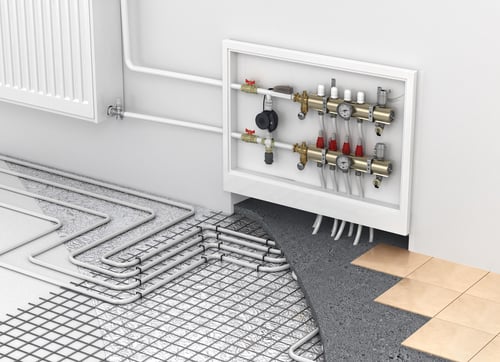Mechanical Engineers Explain Why Many HVAC Systems Use Water to Move Heat

HVAC installations are characterized by the wide variety of system configurations available. You may have noticed that many HVAC systems do not heat and cool indoor air directly, and instead they use water as a heat exchange medium. The term “hydronic” is used to describe installations that move heat with water or another fluid.
Since the goal is to control the temperature of indoor air, why is water used for heating and cooling? Hydronic HVAC systems have many performance advantages that will be described in this article:
- Water has a higher density and specific heat capacity than air. As a result, hydronic piping requires less space than air ducts.
- Blowing air vertically to upper floors is difficult, inefficient and impractical. Pumping water through hydronic pipes is much simpler.
- Air ducts can spread dust, mold and other harmful substances. On the other hand, hydronic HVAC systems have a separate air handler for each area.
Determine the best HVAC configuration for your building project.
Hydronic Piping Is More Compact Than Air Ducts
For a given heating and cooling load, a distribution system with hydronic pipes uses less space. This can be explained with the physical properties of air and water:
- Water has a specific heat capacity of 4.187 kJ/kg-K, and a density of 1,000 kg/m3.
- Air has a specific heat capacity of 0.718 kJ/kg-K at constant volume, 1 kJ/kg-K at constant pressure, and a density of 1.225 kg/m3.
One kilogram of water can carry almost six times more heat than one kg of air at constant volume. At the same time, one kg of water needs over 800 times less space than one kg of air.
Reducing the space used by mechanical equipment is beneficial for building developers. The space saved can be used for other building systems or to increase the size of tenant spaces.
Pumping Water Vertically Is Simpler Than Blowing Air
Vertical ducts are common in homes with a furnace in the basement, but the concept works because the vertical distance traveled is small - normally one or two floors. However, vertical air ducts are not feasible when the number of floors increases.
If you use vertical ducts in a tall building, air cannot be delivered effectively to the upper floors because the static pressure is too high. At best, you can expect effective air distribution in the bottom floors. Hydronic pipes with water pumps are much more effective when you need to cool or heat the upper floors.
The combination of vertical hydronic piping and air handlers for each floor is one of the most efficient HVAC options for high-rise buildings. With this type of system, there are two main piping configurations:
- A two-pipe system only has one water loop, which means that all air handlers must be either in heating mode or cooling mode.
- A four-pipe system has two water loops, allowing independent operation of air handlers. You can heat some building areas while other are being cooled.
Hydronic Piping Systems Are Better for Human Health
When an air duct system covers an entire building, air pollutants and unpleasant odors can easily spread to other areas. On the other hand, a hydronic HVAC system separates the building into areas with independent air handlers. This is beneficial for the health of occupants, since harmful substances like dust and mold are easier to isolate and control.

Hydronic HVAC installations can be designed to be embedded on walls and ceilings, and in these case they are called radiant systems. Heating and cooling are delivered directly through the walls and floors, and no interaction with the ventilation system is needed. Radiant HVAC systems are silent and their chance of spreading air pollutants is zero.
Final Recommendations
Hydronic HVAC systems offer many advantages, and they are ideal for the needs of high-rise commercial buildings. However, the best recommendation is getting is getting touch with a MEP engineering firm to specify your HVAC installations. For example, hydronic systems can be expensive for a small residential project, and direct expansion HVAC is likely a better option.
A centralized hydronic HVAC design may also be unsuitable when building areas have independent schedules, since you can end up with a system that runs at a fraction of its rated capacity most of the time. In this case, a separate installation for each building area may be a better option - multi-family residential buildings are an example, since tenants have different schedules and HVAC usage habits.

Anuj Srivastava
Anuj Srivastava is a principal partner at NY Engineers. He is known for his MEP franchise market knowledge. Anuj is currently leading a team of 100+ MEP/FP engineers and has successfully led over 1500 franchise projects in the US.
Join 15,000+ Fellow Architects and Contractors
Get expert engineering tips straight to your inbox. Subscribe to the NY Engineers Blog below.

